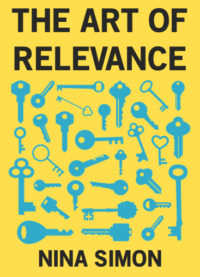 I purchased my copy of Nina Simon’s The Art of Relevance on the first day it was available. I am only now posting comments about it because, frankly, I know more people are paying attention in September than are in July and August.
I purchased my copy of Nina Simon’s The Art of Relevance on the first day it was available. I am only now posting comments about it because, frankly, I know more people are paying attention in September than are in July and August.
Let me begin by saying that Ms. Simon is a gifted, compelling writer. She brings great passion and eloquence to bear on the need for far greater community awareness in the work of arts and cultural organizations. She also has a deep understanding of the power of stories, which she tells well. To say that the book is a quick read is no criticism. Its message needs an army of converts to effect the changes necessary in the nonprofit arts industry.
Ms. Simon is a practitioner with experience in the trenches and results to back up her points. Of course it would be foolish for me not to acknowledge that her focus on connecting arts organizations with their communities directly parallels my own. We plow in at least some of the same fields; there are many parallels between our messages.
Perhaps the best thing I can do here is highlight a few of the “aha” moments for me in the book. Ms. Simon cites Diedre Wilson and Dan Sperber’s work on Relevance Theory as the underpinning for her book. According to them, there are two criteria that make things relevant:
- How likely . . . new information is to stimulate a positive cognitive effect—to yield new conclusions that matter to you.
- How much effort is required to obtain and absorb [the] information. The lower the effort, the higher the relevance. (32)
It’s the second of those that particularly got my attention. And, upon reflection, I’d separate it into 2a and 2b. The logistics of obtaining the information (how easy–and comfortable–is it to get to a venue, is the time convenient, etc.) are one issue we sometimes address in the arts. The second, how readily understandable (as opposed to opaque) is the experience, is one that is less frequently acknowledged. This is a construct that I hope to remember and make use of going forward.
Another valuable insight is that relevance is not the same thing as familiarity. If something is difficult to understand, we of course are less able to see its relevance. At the same time, “When we identify something new that could bring meaning into our lives without a whole lot of effort, we take the leap. We desire relevance, and we’re willing to take a risk and do some work to get it.” (36) Indeed, Ms. Simon notes that sometimes familiarity is the gateway to irrelevance. Many arts organizations take it as an article of faith that offering free food is a valuable means of getting people in the doors. Considering the need for relevance, Ms. Simon’s Museum of Art and History in Santa Cruz eliminated food from its First Friday program. (Food, unless carefully tied to the programming, can be–often is–irrelevant to arts programming.)
Within months, attendance had doubled—and everyone was making the trek up the stairs to exhibitions. Within a year, attendance tripled. 1,500 people were coming monthly for an evening of exhibitions, live music, art activities… and no food. . . . It turned out that the food was not relevant. It was a distraction. (46)
Talk about a counter-intuitive (or counter-common-practice) inspiration!
Finally, for now, the bright lights and loud bells moment for me was her insight that “Relevance is an exercise in empathy–understanding what matters to your intended audience, not what matters to you.” Empathy is a vital word that I have not tapped sufficiently in my work attempting to foster effective community engagement. Thanks, Nina.
Without a doubt, I highly recommend The Art of Relevance. The caveat has to do with how its lessons can be implemented. In this book, in her blog, in my books, in my blog, the function of examples is to show that it can be done–that properly designed and implemented community-aware approaches to mission can have exhilarating effects on our institutions. However, the inertia of mental models about the nature of arts organizations gets in the way, even when the spark of inspiration has lit a fire in the minds of their leaders. In addition, we live in a “best practice” world and look to examples as “how to” road maps. In community/cultural organization relationships the assets-needs-interests of each are unique and the programs that grow out of them are also unique. They are almost never transferrable. At best, we can glean basic principles of program planning and design.
The “how to” is a struggle for most of the organizations with which I have worked. It is certainly a central topic I have attempted to address in this blog and in my second book (Engage Now! A Guide to Making the Arts Indispensable). Moving from inspiration to concrete community-aware action is an existential challenge for our industry. I welcome Ms. Simon’s book and point us all toward the further work that needs to be done.
Engage!
Doug

[…] 13-story Sugar Hill Project in Harlem … read more AJBlog: CultureGrrl Published 2016-09-20 The Art of Relevance I purchased my copy of Nina Simon’s The Art of Relevance on the first day it was available. I am […]
[WORDPRESS HASHCASH] The comment’s server IP (66.33.193.103) doesn’t match the comment’s URL host IP (66.33.193.74) and so is spam.